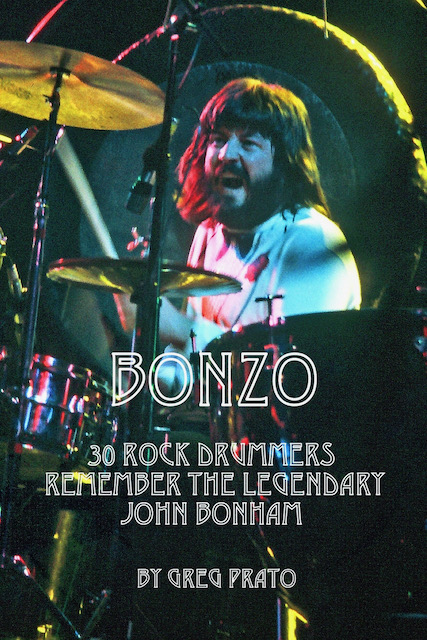
May 31, 2023, marks what would have been legendary Led Zeppelin drummer John Bonham’s 75th birthday. Bonham (who passed away from alcohol poisoning on September 25, 1980, at the age of 32) is widely credited as one of the greatest rock drummers of all-time - whether it be his massive sound (“Kashmir”), widely copied and/or sampled drum beats and fills (“When The Levee Breaks”), or knowing when to play for the good of the song (the drums don’t even begin in “Stairway to Heaven” until the 4:17 mark).
A while back, Greg Prato interviewed some of rock’s most respected drummers for the book Bonzo: 30 Rock Drummers Remember The Legendary John Bonham as a tribute to the Led Zeppelin legend. In celebration of what would have been Bonzo’s 75th birthday, below are excerpts from the book, in which drummers explain what made Bonham such an important and influential drummer.

Charlie Benante (Anthrax): "I think it was all in his wrists. I also know for a fact - because just in reading everything I possibly could on Led Zeppelin through the years - how he would put headphones on when they were recording, and didn’t use many mics on his kit. But the mics that he did use were placed in a certain way that when he heard it back, it sounded exactly how he heard it when he sat there. So, sometimes when you hear drums mixed on a record, they may sound like a little disproportionate type of thing, because the toms don’t sound as equal as the snare or kick. But with him, everything was mixed really well and compressed, so the triplets always came out sounding correct. And he was totally on top of that.
"I heard two different stories about how they got the 'When The Levee Breaks' sound. There’s one story that said his drum kit was delivered at the house that they were recording - Headley Grange - and he was so excited that he put them right in the hall where they were delivered to, and set them up right there. Jimmy heard that, and said, 'Don’t touch them!' And I guess they mic’d it from a staircase up, and put a few more mics down there too, and that’s how they got that sound. That’s one version of it, which sounds like it could have been that way.
"The second version was I heard that they spent time on it, mic’ing and different techniques - putting it out of phase, putting it in phase. I heard all the other stories about it. But I heard it was that Ludwig kit that got delivered - and I guess that was the green sparkle kit."
Frankie Banali (Quiet Riot): "Well, the thing that was really great about both John and Led Zeppelin is that they took risks every single time they played live. They never played the songs exactly the same twice - because they were playing for the moment, which is something that has always been very important to me, and it’s something that I’ve always done with Quiet Riot. You’ll be hard pressed to have any Quiet Riot song sounding exactly the same on any given night. And that’s something that I picked up from Led Zeppelin.
"Because I think the minute that you start using pre-recorded tracks and you play everything exactly the same way twice, a lot of the creativity and spontaneity leaves. I mean, you can’t just completely throw the arrangement away and play it to the point where it’s unrecognizable. But it’s nice to be able to do different fills and take it someplace else every single night. That’s very important to me - it keeps it alive for me. And that’s something that John always did, and everybody in Led Zeppelin always did – you’ll be hard pressed to find any two live recordings that are exactly the same in any way, shape, or form."
Mike Portnoy (Winery Dogs, ex-Dream Theater): "There were so many things [that made Bonham unique as a drummer]. First of all, the sound. He had a sound about him. Whenever people talk about John Bonham, they talk about, 'Oh, how did they mic the drums?' or 'What kind of drums did he use?' or 'What kind of sticks did he use?' I don’t believe the drums or the mic’ing had anything to do with it. I think they had a little to do with it, but it was what was in John’s body and his hands. It’s the way he played. I think you could probably sit him down at any kit, in any environment... and it’s going to sound like John Bonham. And that is the key to any great musician - when you have your own sound and style. He had that sound. He had that groove.
"He was just like a solid anchor, and you could feel that kick drum, and you could feel the hi-hat and the snare groove. At times, it was huge. You listen to the beginning of 'When The Levee Breaks' - it’s just the biggest drum intro of all-time. And then you also hear these subtleties - you listen to the groove in 'Fool In The Rain'. He also knew how to play with finesse and subtleties, as well. So, I think it was the combination of both of those extremes.
"And he also had a great ear for improvising and jamming. If you listen to any live Zeppelin recording - whether it be the official stuff like The Song Remains The Same or How The West Was Won…or even pull out some bootlegs - he played every song and every show completely differently. I think a big part of that was that they listened to each other. You could always tell that Bonham was listening to what was surrounding him, and reacting. I think that was a big part of Zeppelin’s chemistry and magic."
Read more at Heavy Consequence.